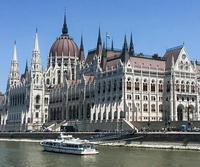Photo. Front view of the Parliament Building. the nation's most important national symbol.
In the hot city Budapest, Hungary, I soaked up the pulsating atmosphere in July 2015, floated on the great Danube River, enjoyed green parks and hills, and admired architectural wonders, especially the Parliament Building. It was really great floating pass the parliament on Danube River, and observing the huge building from different angels. The building's facade is beautifully decorated with eighty-eight statues of Hungarian rulers, pointed arch arcades and numerous gargoyles, spires and Gothic ornaments. The architectural styles - neo-Gothic, neo-Romanesque, neobaroque, with an impressive dome in the middle. The construction of the Parliament House started in 1885. When it was completed seventeen years later, in 1902, it was the largest parliamentary building in the world with a length of 268 meters and a width of 118 meters (879x387 ft).
The Parliament House is arranged around ten central courtyards and contains more than twenty kilometers of staircase, as well as 691 rooms. The building has twenty-seven intricately decorated spires. The impressive dome, visible from a far distance, reaches a height of 96 meters. The magnifiecient building can be observed from from Buda Castle on the top of a hill from the other side of Danube river.
The Hungarian Parliament Building, which translates to House of the Country or House of the Nation), also known as the Parliament of Budapest for being located in that city, is the seat of the National Assembly of Hungary, one of Europe's oldest legislative buildings, a notable landmark of Hungary and a popular tourist destination of Budapest. It lies in Lajos Kossuth Square, on the bank of the Danube. It is currently the largest building in Hungary and still the highest building in Budapest.
Stein Morten Lund, 22nd July 2015












